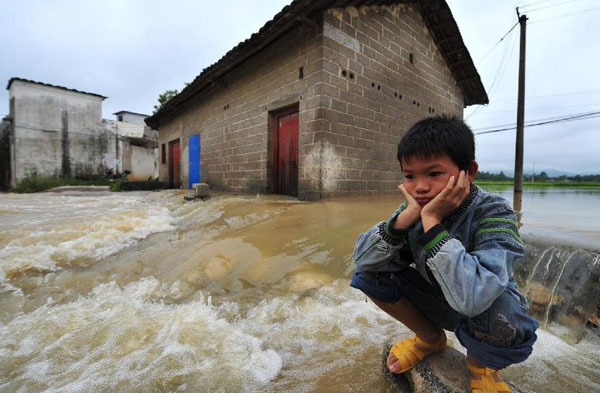Typhoon Nesat kills 3, causes damages
 0 Comment(s)
0 Comment(s) Print
Print E-mail
Xinhua, October 2, 2011
E-mail
Xinhua, October 2, 2011
Typhoon Nesat has brought heavy rains and strong winds to south China, killing three people and causing heavy damages, authorities said on Saturday.
|
|
|
A boy squats beside houses flushed by flood at Guotai Village of Binyang County, southwest China's Guangxi Zhuang Autonomous Region, Oct. 1, 2011. About 1,180,000 residents in Guangxi were hit by Typhoon Nesat, the strongest typhoon hit China this year as of 10 a.m. of local time. A total of 63,200 people were transferred in an emergency.[Xinhua] |
Three villagers died after their homes collapsed in the downpours or being washed away by floods in Lingshan County of Guangxi Zhuang Autonomous Region, said a spokesman with the county government Saturday.
The Typhoon has also disrupted road traffic in the region.
Five highways were cut off by flooding and subsequent cave-ins Saturday, according to Guangxi's regional highway authority.
A rain-triggered cave-in, measuring nearly 3,200 cubic meters, forced the closure of a county highway in the city of Fangchenggang at 1:30 p.m. Saturday. Road authorities said traffic will resume after 2 p.m. Sunday.
Heavy rains played a significant role in rising water levels. A road bridge in the city of Qinzhou was destroyed after being hit by three motorized water vessels. The road bridge, which is in a pivotal section of Provincial Highway 311, is open only to pedestrians and cyclists while repair work is being done.
More than 1.82 million people in Guangxi have been affected by typhoon Nesat, which made landfall Friday, the Ministry of Civil Affairs said in a statement Saturday afternoon.
The typhoon battered 31 counties in eight cities, including the regional capital Nanning, forcing the evacuation of 101,000 people, it said.
The ministry has launched an emergency response plan and sent work teams to Guangxi to assist the relief operations, according to the statement.
The typhoon, packing strong winds and heavy rain, toppled 2,200 homes and damaged 6,100 others.
The economic loss caused by the typhoon was estimated at 1.27 billion yuan (200 million U.S. dollars), said the statement.
Nearly 120,000 hectares of cropland were damaged, of which 3,620 hectares were rendered useless, according to local government statistics.
Rong Jiaqing, a villager in Pubei County in the suburbs of Qinzhou, said nearly all his sugarcane on about eight hectares of farmland had been broken by the high winds.
Winds and rainstorms also damaged about 10 percent of the banana trees on a 1,000-hectare plantation in the county, said Lai Guangwei, a local official in the town of Dacheng.
The regional weather bureau said most parts of Guangxi experienced heavy rains from 8 a.m. Friday to 6 a.m. Saturday. The maximum precipitation reported in the cities of Beihai, Qinzhou, Fangchenggang and Nanning totaled 400 millimeters.
Rain-triggered flooding hit 10 villages in the outskirts of Binyang County in Nanning, where water measured one to three meters, the regional flood control and drought relief headquarters said Saturday.
It also said nearly 10,000 villagers were evacuated.
The typhoon caused mountain torrents that trapped four university students on a wild mountain in the city of Fangchenggang Friday afternoon, prompting an overnight search and rescue operation conducted by the local fire brigade.
The students, including three men and a woman, were rescued at 2 a.m. Saturday.
The regional weather bureau has warned that a second typhoon, Nalgae, is expected to strike Guangxi around Wednesday.







Go to Forum >>0 Comment(s)